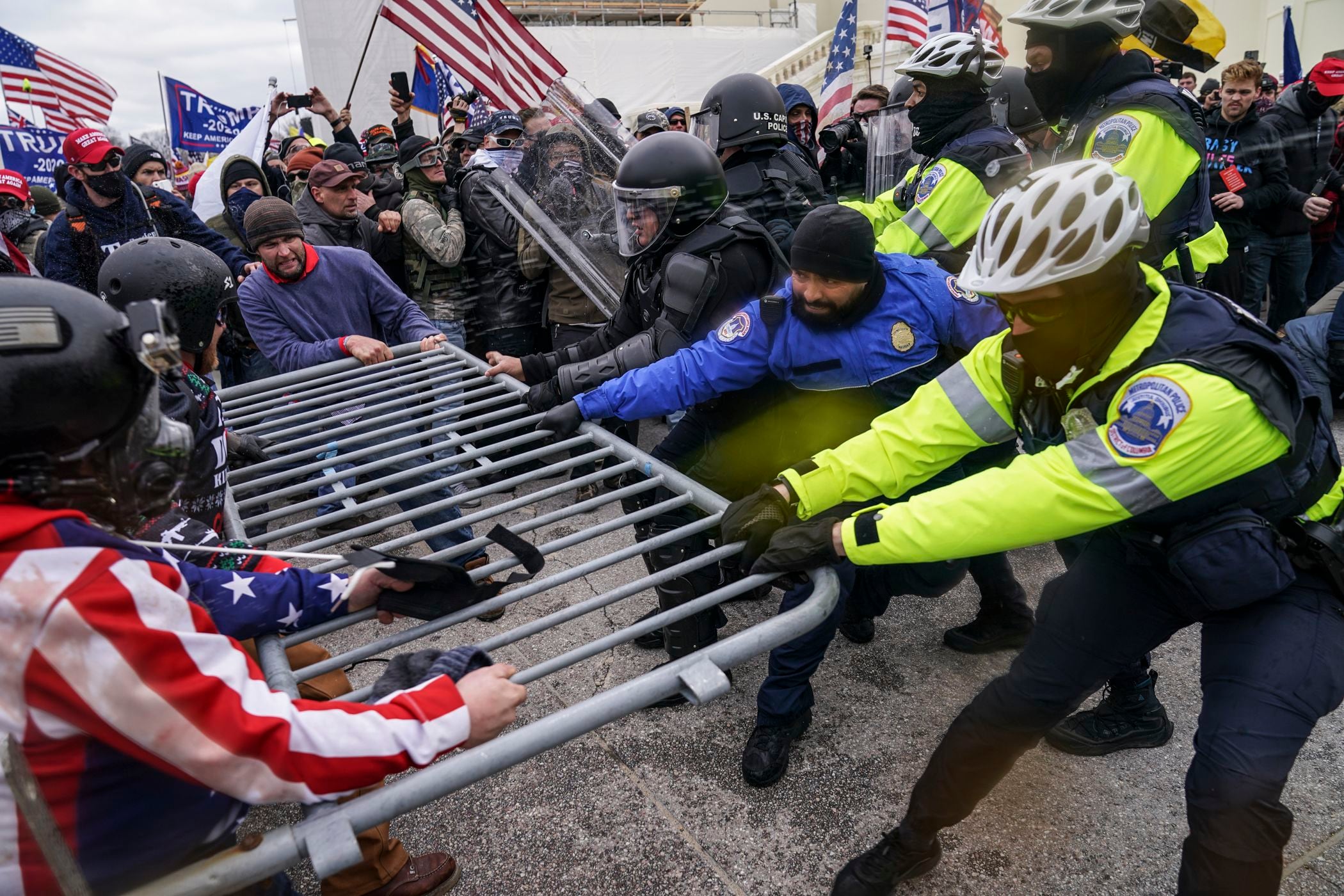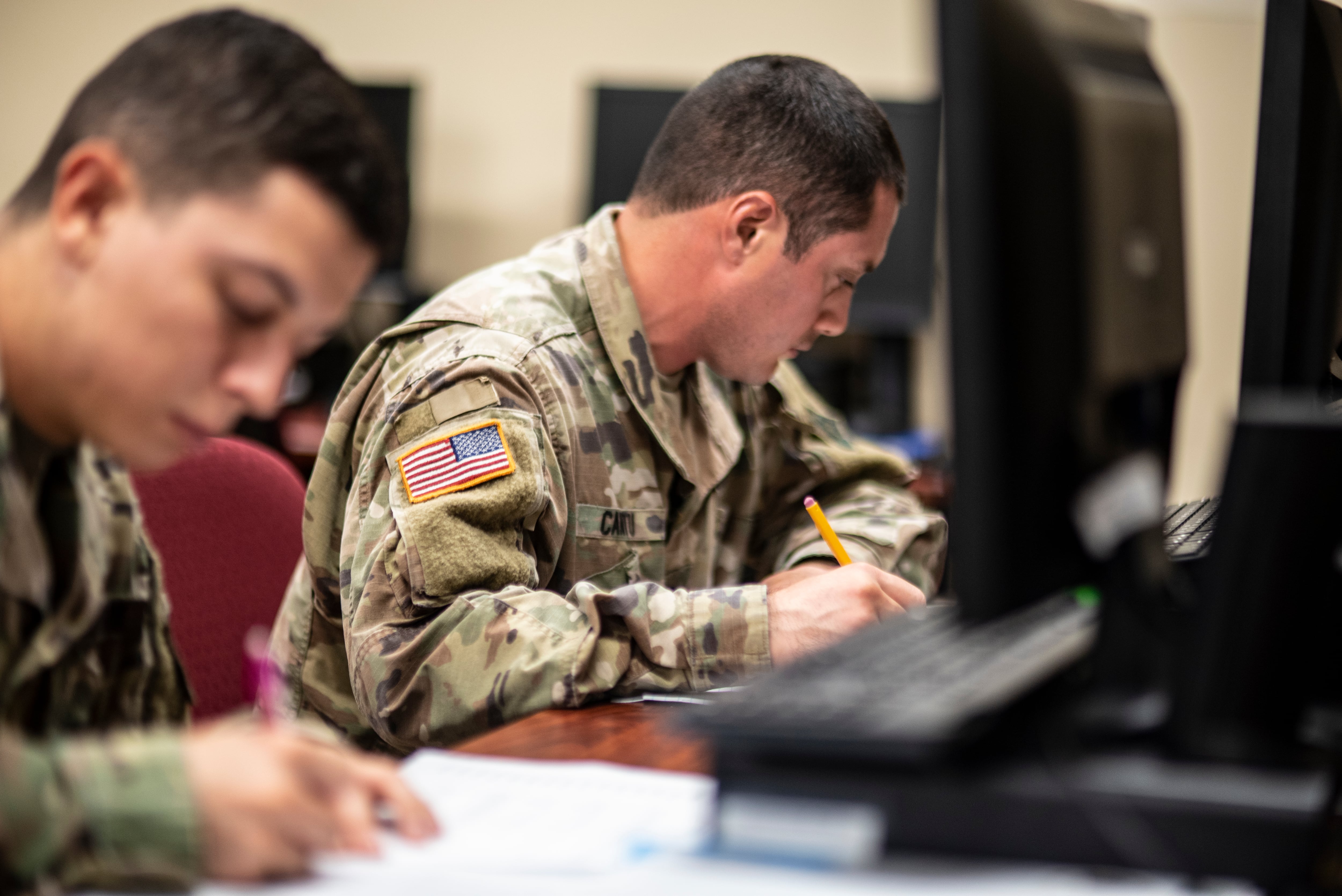IRBIL, Iraq — The U.S. military headquarters here is outfitted with maps showing a "forward line of troops" — a FLOT, in military-speak — that divides northern Iraq's Kurdish region from territory held by the Islamic State group. The line is precisely drawn, following the contours of specific roads and berms. A mere 40 miles west, the terrain is pocked with trenches, fighting positions, razor wire and armed checkpoints. It's like a scene from Europe during World War I, one American official says.
It's a jarring change for the personnel who've spent much of their careers fighting on far more ambiguous battlefields. Steadily, though, they are coming to grips with it as, during the past several months, the Pentagon and the White House have fundamentally shifted their strategy for defeating ISIS. The way forward will mean potentially more key U.S. support troops on the ground to back friendly local forces who will wage the fight to retake ISIS-held territory.
The new plan calls for fighting the terror group like a conventional enemy, relying on traditional military tactics such as maneuver-style warfare and attrition. This has replaced last year’s approach, dubbed the "Iraq First Strategy," which was widely criticized as ineffective, especially after ISIS fighters seized the city of Ramadi in May. Instead, the U.S. and its allies now intend to confront the extremist group and its force of about 30,000 fighters, targeting their strongholds and resources across Iraq and Syria simultaneously.
Publicly the Obama administration says its strategy to defeat ISIS has not changed significantly, but realities on the ground and discussions at home indicate otherwise. Details about the shift became clear during the past several weeks, after a series of interviews that Military Times conducted with top commanders in Iraq, senior defense officials in Washington and outside military experts keenly familiar with the Pentagon's war plans.
Political considerations in Washington and Baghdad will limit the size of the U.S. force on the ground, so the campaign relies heavily on a dizzying patchwork of local ground forces — often with competing agendas — moving in large formations to isolate and ultimately invade the two major ISIS strongholds: Mosul in Iraq and Raqqa in Syria. In Mosul, the plan calls for the Iraqi army to attack from the south, while the Iraqi Kurdish peshmerga squeeze Islamic State forces from the north and east. In Syria, U.S. forces will support friendly militias in the northeast as they push south toward the Islamic State's defacto capital.
"Our campaign plan's map," Defense Secretary Ash Carter told soldiers at Fort Campbell, Kentucky, on Wednesday, "has got big arrows pointing to both Mosul and Raqqa."
In a secondary front, the Iraqi army will move west from Ramadi, the recently reclaimed capital of Anbar province, up the Euphrates Valley and toward the Syrian border. Another key pillar of this strategy requires cutting off the Islamic State's primary supply line to the outside world by pressuring Turkey to seal its border with Syria.
The new strategy coincides with the October appointment of an Army stalwart, Lt. Gen. Sean MacFarland, former commander of the First Armor Division, as the first flag officer to oversee all anti-ISIS operations in both Iraq and Syria. "Before that, the senior guys on the ground were pretty much from the special ops community," said retired Army Col. Peter Mansoor, a former top adviser to U.S. commanders in Iraq who now teaches military history at the Ohio State University. "And now to put in someone who has a more conventional background … does signal that this is going to be a much more conventional fight than the [Obama] administration had first calculated."
Meanwhile, Iraqi leaders have begun imposing restrictions on the size and scope of the U.S. military force in their country. Factions within Baghdad’s Shiite-led government are influenced by neighboring Iran and thus oppose expanding the American military mission there. "Iraq is proving to be a lot trickier than we thought," said Michael Knights, a military expert with the the Washington Institute for Near East Policy. "You’ve always got the risk that you can unbalance the government if you do too much. ... We've learned that it can be a lot simpler operating in an environment where you have no sovereign government [like Syria] than to operate in a place where you’ve got one, like in Iraq."
The new battle plan has many potential pitfalls, of course. And there are no clear plans for ousting ISIS militants from their strongholds in Syria west of the Euphrates River, where several rebel factions are fighting to overthrow Syrian President Bashar al-Assad, who has been buoyed by Russian military forces that have established an air base along the Mediterranean coast. For the U.S. and its allies, Russia's presence and activity in the region only further complicates an already convoluted pocket of Syria’s five-year-old civil war.
This campaign will take years to execute, officials say. But it is underway, both operationally and politically. Carter's recent trip to the region, which included stops here in Irbil, Baghdad and Turkey, set things in motion.
By severing the ISIS supply line between Raqqa and Mosul, military officials hope to carve up the group's territory into smaller pockets that can be defeated through isolation and attrition or direct assault. This began with the November attack on Sinjar in Iraq's northwest. The fight was led by Kurdish peshmerga forces, with U.S. warplanes and combat advisers providing support. Their effort was mostly successful, although ISIS continues to move some people and supplies between the two cities using secondary roads.
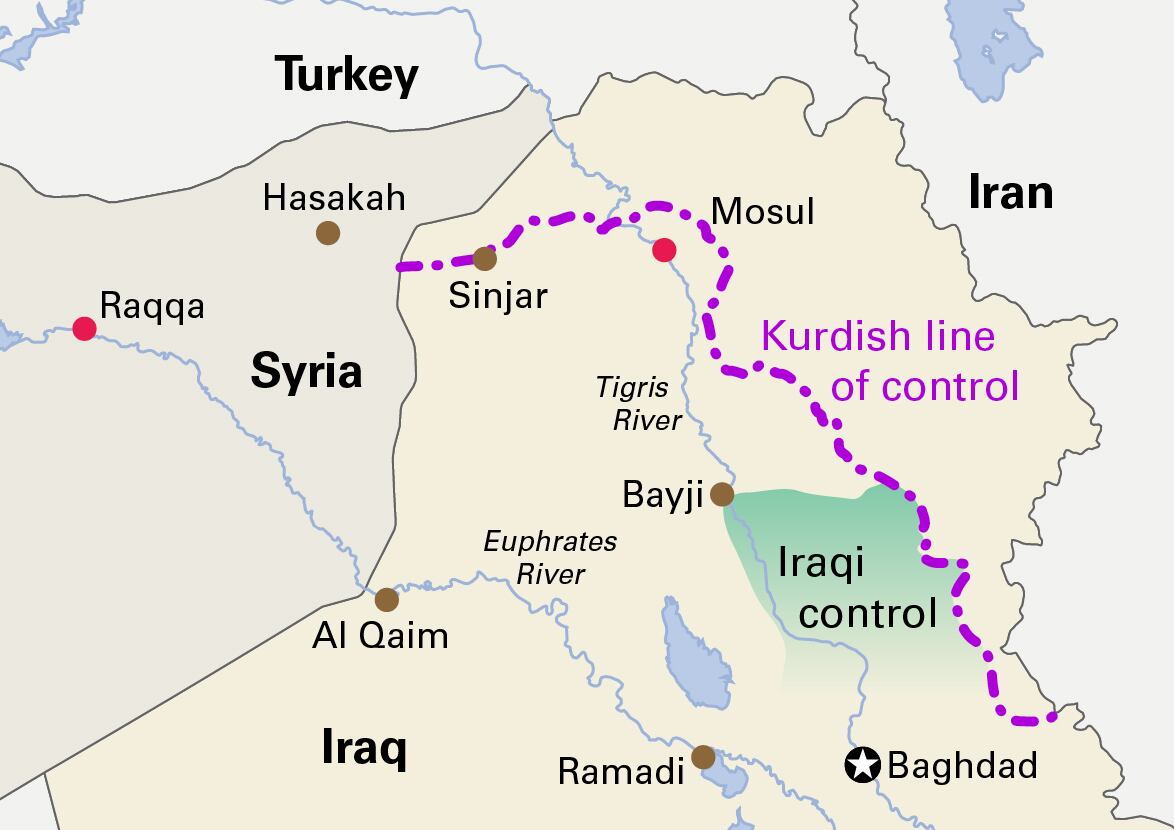
November's fight to retake Sinjar was mostly successful in disrupting the Islamic State group's ability to shuttle people and supplies between its strongholds in Mosul and Raqqa, though they are still able to transit some secondary roads.
Photo Credit: John Bretschneider/Staff
"It doesn’t eliminate or cut off their ability to resupply," Army Brig. Gen. Mark Odom, the top U.S. commander in Iraq’s Kurdish region, told Military Times in December. But those secondary roads, some of them unpaved or in very poor condition, will be difficult for big tractor-trailers and tankers. "Even the best roads," Odom added, "don’t support vehicle movement at more than 35 miles per hour, and they are not going to support an increased amount of traffic. Both in terms of congestion and in terms of speed, those routes to the south present some real problems on the economy."
The U.S. and its allies targeted these secondary roads with airstrikes Dec. 25 and 26, further degrading the transit routes. Those strikes also targeted some roads around the Iraqi city of Tal Afar, another ISIS stronghold situated along the same Mosul-to-Raqqa route.
It's not yet clear when the assault on Mosul itself will begin. Some surmise it may not even happen this year. But when it does the Kurds will be central to the effort. The peshmerga’s forward line now surrounds about half the city to the north and east. To incentivize them, Carter had a face-to-face meeting with Iraqi Kurdish officials in Irbil and promised to give them two brigade-size equipment sets. That includes weapons, tactical vehicles, communications gear and other supplies to outfit a fighting force of up to 4,400.
The U.S. battle plan acknowledges that the peshmerga cannot be the primary invasion force, though. Mosul is a predominantly Sunni Arab city, where ethnic tensions would make Kurdish forces unwelcome. Instead, the Kurds will help "encircle" the city, officials said. Kurdish cooperation also will be vital for handling the humanitarian crisis that's expected to erupt as many of the estimated 700,000-plus civilians who remain inside Mosul flee the fighting.
Officials estimate that between 1,500 and 10,000 ISIS fighters are entrenched in Mosul. If the Kurds apply pressure on the city's north and east, ISIS would have to spread its forces more thinly across the city’s entire perimeter, drawing manpower away from the Iraqi army forces coming up from the south, through the Tigris River valley. The strategy calls for that Iraqi force to be a massive formation — likely more than 10,000 soldiers.
However, many experts question the Iraqis' capability and will to fight, which poses complications for determining the timeline. First, the Iraqis will have to fight ISIS elements distributed throughout a 100-mile corridor stretching from Mosul south to Bayji. And any effort to sustain long-term supply lines will be vulnerable to ISIS guerrilla-style suicide bombs and improvised explosive devices.
The Pentagon has acknowledged that the Iraqis will need help. "Reaching and retaking Mosul will not be easy, and it will not be quick. There'll be many engagements in between," Carter said Wednesday. When he met with Iraqi Prime Minister Haider al-Abadi last month in Baghdad, the secretary promised to ratchet up U.S. military support for these upcoming operations. Specifically, Carter offered U.S. attack helicopters, critical for close-air support in a dense urban battlefield like Mosul. He also offered to deploy a new cadre of ground-level U.S. combat advisers to embed with Iraqi army units at the brigade level, a move aimed at magnifying the effectiveness of U.S. airstrikes and real-time intelligence capabilities.
The Iraqis declined such support for the recent fight in Ramadi, a clear sign that anti-American politics in Baghdad may limit the U.S. military’s ability to operate inside Iraq. As such, the U.S. will send more troops and helicopters only if the Iraqis issue a specific request. So for now, it’s a standing offer. "We're prepared to do that and the government of Iraq knows we're prepared to do that," MacFarland said. "We're prepared to say yes if requested."
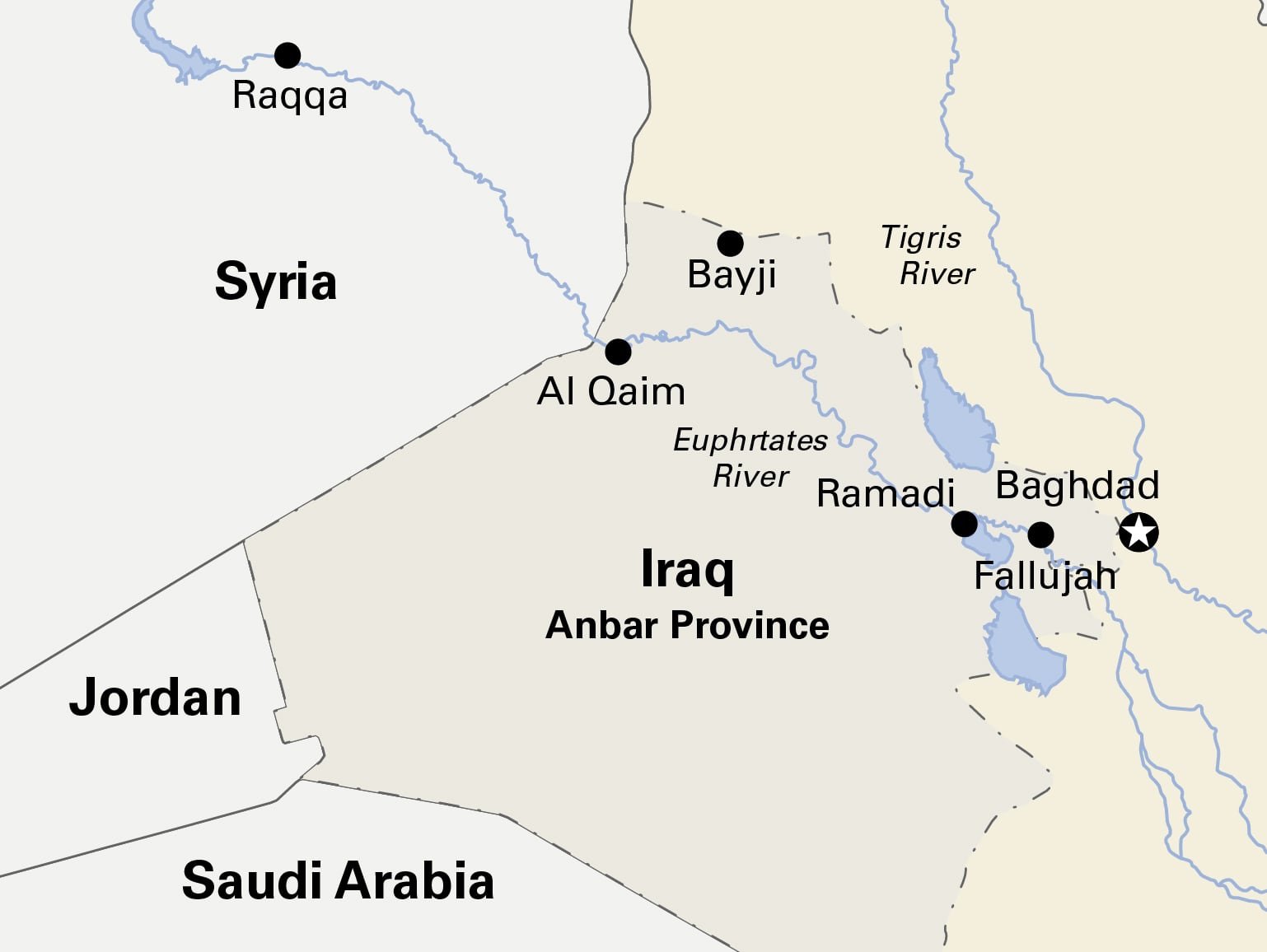
By securing Iraq's traditional border with Syria at al Qaim, the anti-ISIS coalition will cut off a potential escape route once the extremists are pushed out of their stronghold in Raqqa.
Photo Credit: John Bretschneider/Staff
The U.S. also is ready to help secure the Iraqi army's supply line toward Mosul. "As the Iraqis move themselves farther and farther up the Tigris and Euphrates River valleys, pushing the enemy out of Iraq, sustainment becomes more of a challenge," MacFarland said. "... Your lines of communication are getting longer.
"Nobody does sustainment, nobody does expeditionary operations better than the United States of America, so there are ways that we can help them with that."
Finally, the Iraqis will need to lock down their traditional border with Syria. To do that, security forces will have to clear out ISIS fighters as they push west from Ramadi to al Qaim. "The next step is to continue clearance of the Euphrates River Valley," said Army Col. Steve Warren, a Baghdad-based spokesman for U.S. and coalition forces battling ISIS. "Next stop Hit. Next stop Haditha."
Once al Qaim is secure, friendly forces will be within striking distance of the lucrative oil production facilities that ISIS controls in Syria. And this would remove another option for ISIS to retreat from Raqqa. If successful, this part of the plan also would isolate Fallujah, a notorious hotbed of jihadism on the outskirts of Baghdad. ISIS has controlled Fallujah for two years, which suggests that any invading force will find heavy defenses and a sympathetic population. Both U.S. and Iraqi military leaders dread the prospect of a block-by-block fight there.
There are currently about 3,500 U.S. troops deployed to Iraq and up to 50 special operations troops in Syria, defense officials say.
U.S. Special Forces teams entered war-torn Syria for the first time in December to meet face-to-face with friendly militia leaders. The meeting was to verify the militias’ size, assess their capabilities and talk to leaders of the individual factions about their own local agendas and how to align them with the broader U.S. battle plan. For the planned assault on Raqqa, the forces receiving U.S. support have several possible approaches.
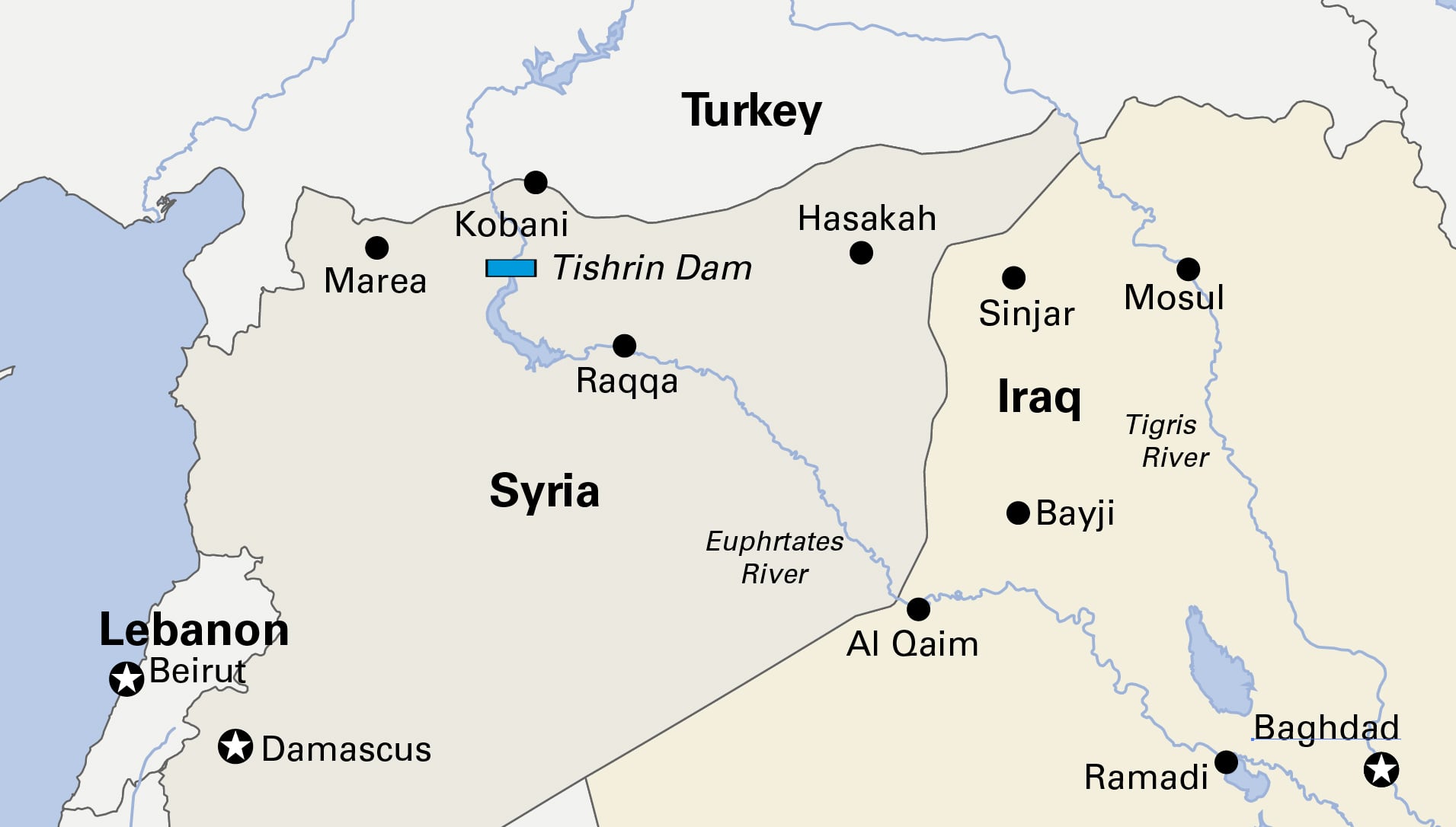
In Syria, U.S. firepower is hitting ISIS oil facilities southeast of Raqqa, not far from the Iraq border.
Photo Credit: John Bretschneider/Staff
From the north, the militias are moving from the Kobani area, along the Euphrates. In late December, they captured a key dam, rolling back ISIS-held territory to about 70 miles from Raqqa. With control of the dam and its bridge, they've also cut a key ISIS supply line to the area it controls around Allepo and Manbij. And to the northeast, other militias receiving U.S. support are mounting offensive operations in the Hasakah area, which sits on the Syrian side of that vital transit corridor between Mosul and Raqqa. "In the coming weeks, you're going to see significant fighting in that area as ISIL realizes that Shadadi is a key node in their lines of communications," said Air Force Col. Pat Ryder, a spokesman for U.S. Central Command.
American officials describe their relationship with these friendly forces as "transactional," meaning the U.S. will provide weapons, ammunition, close-air support and other assistance if and when specific factions of the so-called Syrian Defense Forces show progress on the battlefield. Meanwhile, U.S. airstrikes continue to target infrastructure affiliated with Syria's oil production, a vital revenue source for ISIS. Most of these oil fields are in the lower Euphrates valley, southeast of Raqqa, not far from the Iraq border.
As in Iraq, the U.S. must consider ethnic identities in their battle plan for Syria. Syrian Kurds, though reliable and effective allies, are not an ideal invasion force for Raqqa, a Sunni Arab city. That’s why the U.S. encouraged the creation of the Syrian Defense Forces, an alliance publicly announced for the first time in October. U.S. officials frequently highlight the SDF's non-Kurdish components, but the true extent of Arab support remains unclear.
"The U.S. has figured out that it wants Arabs to do the job" in Raqqa, said Aron Lund, a Syria expert with the Carnegie Endowment for International Peace in Sweden. "They realize they need that. If they sent in this ultra-secular Kurdish group into a city of rather conservative Arab tribal groups, that would not work out very well." The U.S. has tried to "play down" the SDF's Kurdish element and "make it into a multietchnic, multisectarian thing," Lund added. "They see that as being the only way to take Raqqa. But in reality, it’s very clear that for the command and control for all of the offenses, the Kurds are doing this. It's the same Kurdish force doing the heavy lifting."
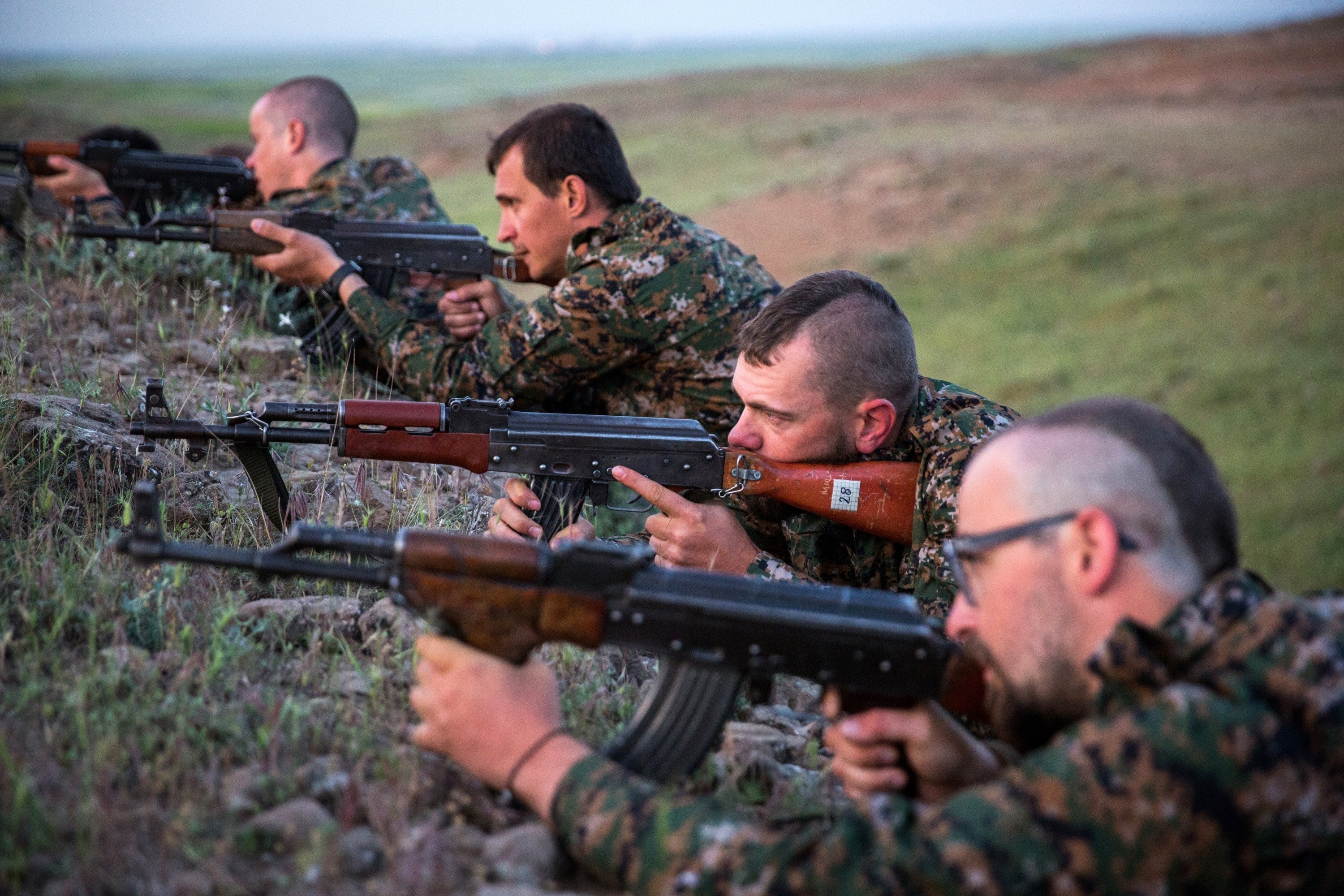
The Kurdish People's Protection Units, or YPG, have attracted foreign fighters eager to battle jihadists and Islamist rebels in northeastern Syria. Here, men train last April in Ras al-Ain, close to the Turkish border.
Photo Credit: Uygar Onder Simseki/AFP/Getty Images
Raqqa is a focal point of the new campaign not only because it is a political stronghold for ISIS but because it is geographically central, and seizing it would fracture the group’s existing territory. It's also a primary route for shipping oil into black markets in Turkey.
"They are trying to cut up the Islamic State into islands of control," Lund said.
It's unclear exactly how much influence the U.S. has in this region, however. Lund believes officials are "moving ahead piecemeal, trying to put pressure on the Islamic State and thinking as they go."
"If we do this, what will happen? Is there a road we can cut? Is there a village we can take? Is there an oil field we can dislodge them from?" he said. "The hope is that with enough pressure, the support for the Islamic State will crack."
The Islamic State's lifeline to the outside world — for money, weapons and people — runs through Turkey's porous southern border. Convincing the Turks to seal off that area is central to the new strategy. A rocky alliance between Washington and Ankara got an important boost in July, when the Turks began allowing U.S. combat aircraft to fly from Incirlik Air Base, putting ISIS safe havens in Syria within easy reach. And now the U.S. is leaning on the Turks to do more. "The single most important contribution that their geography makes necessary is the control of their own border," Carter noted while speaking to Military Times and other media traveling with him in December.
The most important border zone is near the city of Marea. This so-called Marea line is a part of ISIS-controlled territory in Syria. Many experts say this region is not a priority for Turkey, which for years tacitly supported ISIS in its fight against Assad. "The Turkish government has not shown the inclination nor the ability to interdict any of this," said Christopher Harmer, an analyst with the Institute for the Study of War in Washington. "If part of the U.S. strategy is that Turkey is suddenly going to crack down on the border, that’s unrealistic."
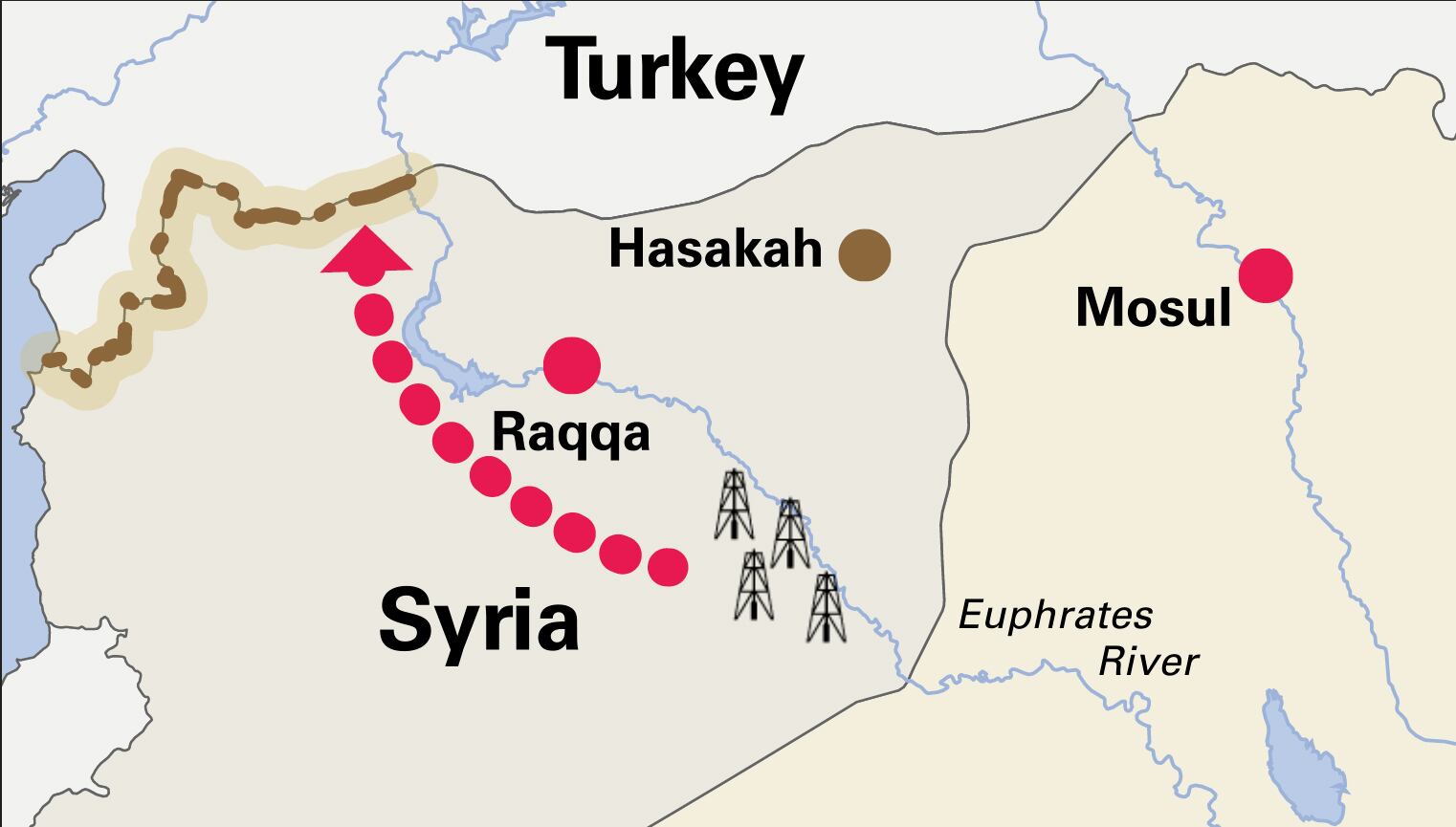
The U.S. is pressuring Turkey to crack down on ISIS activity on its side of the border.
Photo Credit: John Bretschneider/Staff
Yet the Turks may change their priorities as the U.S. military empowers Syrian Kurdish forces, known as the YPG. Turkish leaders have been engaged in a decades-old conflict with its own Kurdish minority and do not want to see the Syrian Kurds expand. For now, the U.S. has agreed not to support Syrian Kurdish operations west of the Euphrates River. However, if Turkey fails to seal off its side of the border, the U.S. could move to help the YPG try to block ISIS in that zone.
"The border is going to get cut one way or the other, either by the Syrian Kurds or Turks," Knights said. "If Turkey wants to maintain any type of non-YPG controlled Syrian border area, it's probably going to have to play ball with the U.S."
The U.S. battle plan includes few details for the ISIS strongholds west of the Euphrates River, including Aleppo. Assad still holds large swaths of territory there, as do groups linked to al Qaida. Russia also is active in that region, and without a major ally on the ground, the U.S. has few good options. Bottom line: Any major American-backed operation in northwestern Syria would have several unknowable second- and third-order effects. "We just don’t know," Knights said, "if we’d be doing more harm than good."
The Iraqis, meanwhile, will need to lock down their traditional border with Syria. To do that, security forces will have to clear out ISIS fighters as they push west from Ramadi to al Qaim. "The next step is to continue clearance of the Euphrates River Valley," said Army Col. Steve Warren, a Baghdad-based spokesman for U.S. and coalition forces battling ISIS. "Next top Hit. Next stop Haditha."
Once al Qaim is secure, friendly forces will be within striking distance of the lucrative oil production facilities that ISIS controls. And this would remove another option for ISIS to retreat from Raqqa. If successful, this part of the plan also would isolate Fallujah, a notorious hotbed of jihadism on the outskirts of Baghdad. ISIS has controlled Fallujah for two years, which suggests that any invading force will find heavy defenses and a sympathetic population. Both U.S. and Iraqi military leaders dread the prospect of a block-by-block fight there.
The U.S. battle plan includes few details for the ISIS strongholds west of the Euphrates River, including Aleppo. That's the eye of the storm in Syria's five-year-old civil war. The Assad regime is holding large swaths of territory. Groups linked to al-Qaida hold some ground. And Russia maintains a large airbase and is concentrating its airstrikes in support of Assad's forces west of the Euphrates. For now, the U.S. has promised Turkey not to give the Kurds military support for operations west of the Euphrates River, which gives the Pentagon no major ally on the ground in that area and greatly restricts its military options.
Bottom line: Any major American-backed operation in northwestern Iraq would have many unknowable second- and third-order effects.
"We just don't know if we'd be doing more harm than good," Knights said.
Among the greatest questions that remain is timing. U.S. military officials have been talking about Mosul for months, while saying little about Raqqa. But Raqqa may emerge as a more achievable near-term goal. "I bet you Mosul is going to prove difficult and that maybe we end up doing Raqqa first. The target is not as hard as Mosul," said Knights, who was a member of a military advisory group in Iraq a few months ago. "I think it’s something we can do in the first half of 2016, whereas I don't think Mosul really is."
But another unknown is the true depth of ISIS support in these cities. Many U.S. officials hope that once an invasion force arrives, armed resistance will erupt inside these cities and help expedite the extremist group's defeat. "I do think that when the Islamic State starts to lose control over these areas, it could happen pretty quickly," Lund said. "If they start to weaken and can't pay their fighters and can't protect their fighters, then some of them might split off and become neutralized. I don't think we’ve seen much of that yet. There are certainly a lot of groups that would probably like to rise up against the Islamic State, but they don't see that as a viable option. If the U.S. is able to bring a force to that region of Arabs and Kurds and others, with an air of inevitability, then maybe that calculus would change."
That raises this question: What happens when — and if — ISIS is defeated? Who will control these two conservative Sunni Muslim cities?
Mosul is home to many former Baathist military officers and Islamic extremists. "The sort of people who stand up and liberate Mosul are likely to be al Qaida," Knights said. "That is the reality of it. It’s going to be interesting to see who takes over the city."
American veterans of the previous Iraq war warn that a counterinsurgency phase may follow the collapse of ISIS's statelike institutions. "There will be a lot more conventional aspects to the fighting, but it doesn’t negate the need to control the population once conventional operations are over," Mansoor said. "So the force on the ground should not disregard the lessons of the past 13 years."
Andrew Tilghman is the executive editor for Military Times. He is a former Military Times Pentagon reporter and served as a Middle East correspondent for the Stars and Stripes. Before covering the military, he worked as a reporter for the Houston Chronicle in Texas, the Albany Times Union in New York and The Associated Press in Milwaukee.



